Advanced Techniques
by Michael Frye | May 11, 2016 | Advanced Techniques, Digital Darkroom, Yosemite Photo Conditions
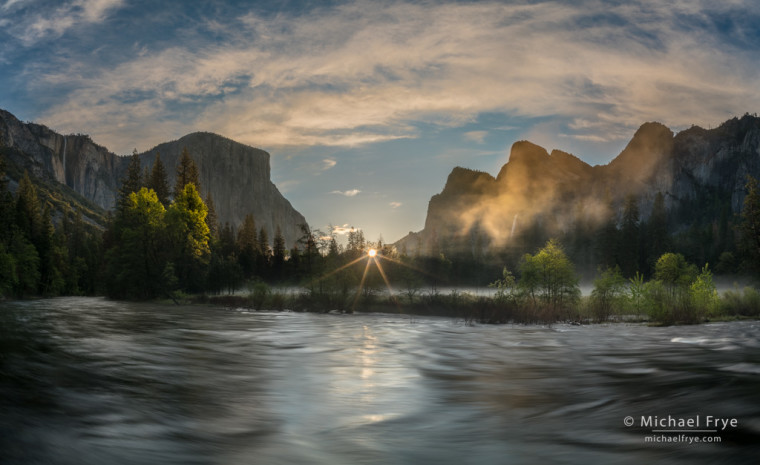
Spring sunrise, Gates of the Valley, Yosemite, Sunday morning
First, to my subscribers, thanks for your understanding about the email glitches yesterday. I really appreciate all the supportive emails so many people sent. Your kind words turned a frustrating day into a great one.
I haven’t posted anything new on the blog for awhile because I was teaching a workshop, and then working on our new website. The new site is still a bit of a work in progress, so if you find any broken links or other issues please let me know. But the new site better integrates the blog with the other content, makes it easier to add and update portfolios, and will work much better with phones and tablets, so I hope it will be a better experience for everyone.
Meanwhile we had a great workshop, with flowing waterfalls, fresh spring greenery, dogwoods, and some interesting weather and clouds. And the cool, showery spring weather has continued, which I love. I’m not ready for the summer heat, and always happy to have clouds and mist to photograph.
(more…)
by Michael Frye | Apr 11, 2016 | Advanced Techniques, Yosemite Photo Conditions
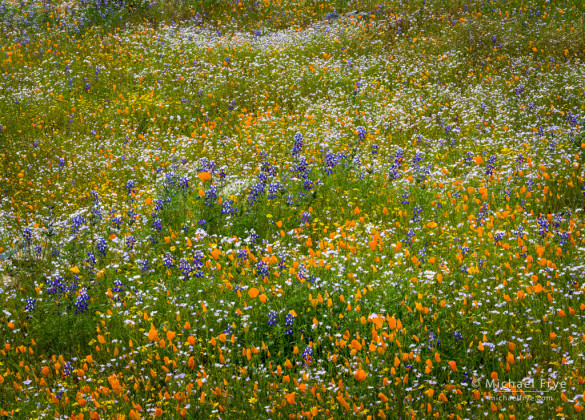
Poppies, lupines, goldfields, and tri-colored gilia, Merced River Canyon, Wednesday afternoon. A focus-stacked blend of four different frames.
It’s spring, which means it’s wildflower season, and focus-stacking season.
There’s been a secondary poppy bloom in the eastern end of the Merced River Canyon near El Portal. No big swaths of poppies, but smaller patches, and some of those patches are mixed with other flowers, which always makes things more interesting. Claudia and I spent the afternoon up there on Wednesday, and had a great time. I’ve included a couple of my favorite images from that day here.
As I was processing the images later, it occurred to me that all of them required focus stacking. Literally every single one. And this is very common for me when photographing wildflowers. I don’t need focus stacking often in other seasons, but in spring I use this technique all the time. It’s just difficult to get everything in focus with one frame when photographing wildflowers. I’m frequently picking out a particularly dense patch of flowers, and using a telephoto lens to emphasize patterns and visually compress the space, making the flowers look closer together. Even with careful focusing and f/22 it’s impossible to get everything in focus with a long lens raking across a field of flowers like that. But even with wide-angle lenses it’s sometimes difficult to get everything in focus with one frame, because I’m getting really close to the foreground flowers, so there’s a tremendous amount of depth.
(more…)
by Michael Frye | Mar 20, 2016 | Advanced Techniques
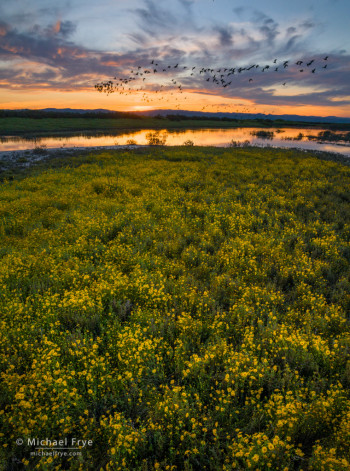
White-faced ibises, goldfields, and a vernal pool at sunset, San Joaquin Valley, Calfornia
There’s often an element of luck in landscape photography. Of course, as Ansel Adams said, “Chance favors the prepared mind.” You have to try to put yourself in the right place at the right time, and then make the most of the opportunities you get. But sometimes luck goes above and beyond.
Yesterday Claudia and I made a day trip to the Bay Area on business, and on our way home we decided to check out some vernal pools in the San Joaquin Valley. Vernal pools fill with water during the winter rainy season, and then slowly evaporate during the spring. As they evaporate, flowers grow along their shores, sometimes forming concentric rings of color. As California’s Central Valley got plowed and paved over, vernal pools became increasingly scarce, so they’re home to several rare species of plants and animals. Most of the remaining vernal pools can be found along the edges of the valley, where the land rises slightly, but the San Luis National Wildlife Refuge complex and Great Valley Grasslands State Park have preserved some vernal pools in the heart of the San Joaquin Valley, and that’s where we headed.
(more…)
by Michael Frye | Jan 10, 2016 | Advanced Techniques, Light and Weather
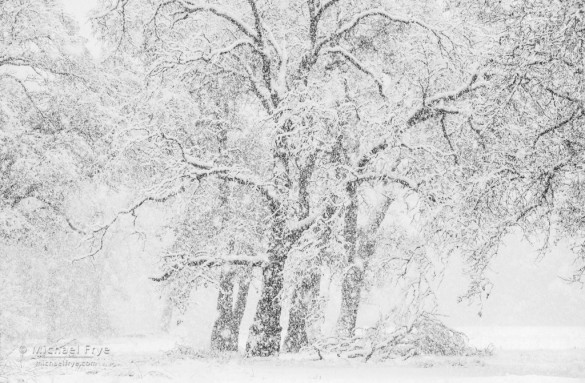
Snowy oaks, Yosemite. 1/125th of a second at f/11, 800 ISO, 150mm.
On Wednesday Claudia and I were in Yosemite Valley during a snowstorm. At times the snow was heavy, and wet, with big, fat flakes falling. It’s difficult to keep the camera dry and prevent water drops from getting on the lens under those conditions, but if you can manage that stuff you can find some beautiful scenes. The falling snow thickens the atmosphere, creating a fog-like effect, and the falling flakes themselves add to the snowy mood.
When it’s raining or snowing a lens hood is essential to keep water drops off the front glass. You also need to constantly check the front of the lens to make sure it’s clean, because it’s hard to see the drops through the viewfinder, but they become glaringly obvious later when looking at the images on a big screen, and are often impossible to clone out or otherwise fix. Telephoto lenses have longer hoods, which are better for keeping the front glass dry; all the photos here except one were made with my 70-200mm zoom.
(more…)
by Michael Frye | Dec 29, 2015 | Advanced Techniques, Composition, Light and Weather
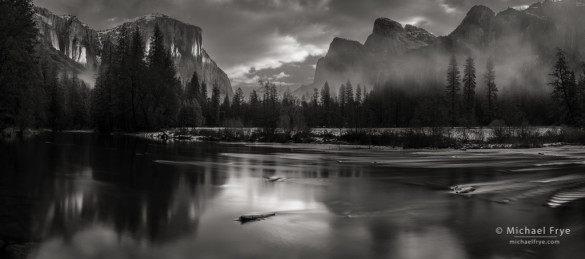
Morning light, Gates of the Valley, Yosemite NP, CA, USA
After the big rainstorm last week I drove up to Yosemite Valley early Wednesday morning. I knew there wouldn’t be fresh snow, but I hoped for some mist and interesting light. It turned out that mist was scarce, probably due to below-freezing overnight temperatures, but there was a little bit here and there.
I stopped at a couple of places, and found myself at Gates of the Valley (aka Valley View) as the sun started to hit El Capitan and light up the clouds above. After making a few photographs with fast shutter speeds, I decided it would be more interesting to smooth out the water with a very slow shutter speed. My seven-stop neutral-density filter did the trick, allowing me to lengthen the exposure to 15 seconds. Thinking about the nighttime panorama I made from this spot recently, I decided to try that again, using my 24mm Rokinon lens in a vertical orientation, and making four exposures to capture the broad sweep of this scene. After a few minutes the light actually got more interesting, with a thin beam of sunlight raking across the face of El Cap.
(more…)
by Michael Frye | Jun 20, 2014 | Advanced Techniques, Composition
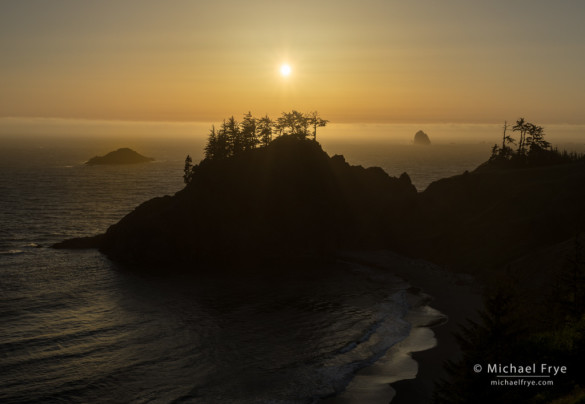
Sun setting over the Pacific Ocean, southern Oregon
After our redwoods workshop, Claudia and I drove north and spent a couple of days along the Oregon coast. I’d never been to this area before, so on our first afternoon we scouted a number of locations north of the town of Brookings. We made several short hikes down steep trails to the coast, with correspondingly steep climbs back out. Though we found some nice spots, none made me jump up and down. Sunset was approaching, and I had to decide where to go. I could see some interesting sea stacks to the north, and decided to drive in that direction.
But we never made it to those sea stacks, because before we could get there we checked one more viewpoint, and immediately realized we didn’t need to go any further. We’d found a scene that practically composed itself, with all the elements nicely balanced and arranged: two stands of silhouetted trees on a ridgeline, with an offshore rock placed perfectly in the gap between the trees, and another rock spaced neatly out to the left. There was even a scalloped line of waves in the foreground to lead the eye toward that gap and the distant rock.
(more…)














